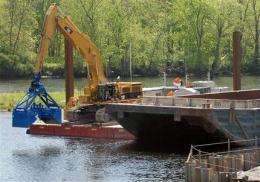Critics: Burial site for Hudson PCBs is inadequate

(AP) -- Later this month, the first trainloads of PCB-tainted sludge dredged from the Hudson River will arrive and, in the eyes of critics, will turn a stretch of West Texas into New York's "pay toilet."
They argue that burying dirt so toxic that General Electric Co. will spend at least six years and an estimated $750 million to dig it up will only create a new mess for future generations to clean up.
But for 15 new jobs and the little bit of money it'll bring local businesses, the folks who live near the site are willing to take the risk, however remote, of tainting the area's ground water by taking out somebody else's trash.
"The city is not against it and the city is not in an uproar," said Matt White, mayor of nearby Eunice, N.M. "It is a big impact on our city and definitely positive ... so we're very comfortable with it."
The deal has the blessing of government officials in both states, and New York environmental groups who have lobbied for decades for the removal of the sludge say it will substantially lower the risk of PCBs - a likely carcinogen in high doses in humans - getting into the food chain.
White said the process is completely safe and there's no risk to Eunice's 3,000 residents in bringing the contaminated dirt into their back yard.
And the Dallas-based company that operates the disposal site, Waste Control Specialists, stands to make tens of millions of dollars, according to a company spokesman who declined to give an exact dollar amount.
PCBs, or polychlorinated biphenyls, are a family of chemicals commonly used as coolants and lubricants in electrical transformers before they were banned in 1977. GE plants in upstate New York discharged wastewater containing PCBs into the Hudson River over several decades.
Waste Control plans to bury the tainted soil on top of 800 feet of clay and to cover it with plastic lining and uncontaminated soil. It also stores radioactive waste at the site, including 45,000 tons of waste from a former uranium-processing plant.
Ordinarily, the clay would prevent the PCBs from seeping into the groundwater below. But critics say the clay underlying the storage site has cracks.
Glenn Lewis, 61, a former technical writer with the Texas Commission of Environmental Quality, said geologists studying the site had recommended Waste Control not be licensed to dispose of the low-level radioactive waste after discovering problems with the clay, including holes and fissures of various widths.
The "geology is awful. It leaks," said Lewis, who compiled the geologists' findings. He called the site "irredeemably inadequate" for radioactive waste.
One of the geologists who advised against licensing the company, Pat Bobeck, declined to comment about the matter to The Associated Press when reached by phone Thursday.
Lewis said he hasn't studied the parcel of clay where the PCB-laden dirt will be buried, but he said it's adjacent to the parcel of land where the radioactive waste is buried, and geology of the two sites is likely the same.
Melanie Barnes, a geology researcher at Texas Tech University, said there are fractures in the clay but that it's unknown if they reach all the way to the ground water. As such, she said she doesn't think burying the PCBs at the site is unreasonable.
Chuck McDonald, a spokesman for Waste Control, said such concerns are unfounded, and that the site has received federal and state approval.
White said a leak wouldn't affect Eunice's drinking water because it comes from a part of the Ogalalla Aquifer that is more than 20 miles from the site.
Another aquifer, the Santa Rosa, is near the site. People don't drink the Santa Rosa's brackish water, but it is used to water livestock, which could transfer PCBs to the human food chain in the event of a leak, Lewis said.
GE ship the PCB-laden river silt to the Texas site by train. It plans to complete transport of material from the cleanup's first phase by November. To date, GE has spent $629 million to clean up the river.
Neil Carman, an official with the Sierra Club in Texas, says the Environmental Protection Agency is letting GE use the "cheapest option" by not requiring it to neutralize the PCBs at a treatment facility it built near the dredging operation.
"There's no cleanup. It's just gone from the Hudson River," Carman said. He called Waste Control a "cheap pay toilet ... the cheapest GE could find," and said burying the dirt is only leaving a toxic mess for future generations.
In an April 21 letter to the Sierra Club, the EPA said it considered "feasible" treatment technologies GE could have used, but that the cost was "substantially more" than disposing of the chemical in an offsite location.
Rose Gardner, who is among a vocal minority in Eunice that opposes the plan, said it's hard to rationalize how bringing in thousands of tons of another state's contaminated soil will benefit her city.
"My real concern is the groundwater," she said. "What it all boils down to is we all need good clean water to survive. It's not a very good scene."
©2009 The Associated Press. All rights reserved. This material may not be published, broadcast, rewritten or redistributed.















